
A pika is a small, mountain-dwelling mammal native to Asia and North America. With short limbs, a very round body, an even coat of fur, and no external tail, they resemble their close relative, the rabbit, but with short, rounded ears. The large-eared pika of the Himalayas and nearby mountains lives at elevations of more than 6,000 m (20,000 ft).
Princeps is a Latin word meaning "first in time or order; the first, foremost, chief, the most eminent, distinguished, or noble; the first person". As a title, princeps originated in the Roman Republic wherein the leading member of the Senate was designated princeps senatus. It is primarily associated with the Roman emperors as an unofficial title first adopted by Augustus in 23 BC. Its use in this context continued until the regime of Diocletian at the end of the third century. He preferred the title of dominus, meaning "lord" or "master". As a result, the Roman Empire from Augustus to Diocletian is termed the "principate" (principatus). Other historians define the reign of Augustus to Severus Alexander as the Principate, and the period afterwards as the "Autocracy".

The princeps senatus, in English the leader of the senate, was the first member by precedence on the membership rolls of the Roman Senate. Although officially out of the cursus honorum and possessing no imperium, this office conferred prestige on the senator holding it.

Trachycarpus is a genus of eleven species of palms native to Asia, from the Himalaya east to eastern China. They are fan palms, with the leaves with a bare petiole terminating in a rounded fan of numerous leaflets. The leaf bases produce persistent fibres that often give the trunk a characteristic hairy appearance. All species are dioecious, with male and female flowers produced on separate plants although female plants will sometimes produce male flowers, allowing occasional self-pollination.

The Principate was the form of imperial government of the Roman Empire from the beginning of the reign of Augustus in 27 BC to the end of the Crisis of the Third Century in AD 284, after which it evolved into the Dominate. The principate was characterized by the reign of a single emperor (princeps) and an effort on the part of the early emperors, at least, to preserve the illusion of the formal continuance, in some aspects, of the Roman Republic.
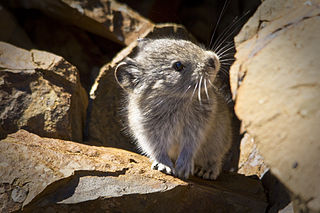
The collared pika is a species of mammal in the pika family, Ochotonidae, and part of the order Lagomorpha, which comprises rabbits, hares, and pikas. It is a small alpine lagomorph that lives in boulder fields of central and southern Alaska (U.S.), and in parts of Canada, including northern British Columbia, Yukon, and western parts of the Northwest Territories. It is closely related to the American pika, but it is a monotypic form containing no recognized subspecies. The name comes from distinctive patches of grayish fur on its nape and shoulders that form a “collar.” It is asocial, does not hibernate, and spends a large part of its time in the summer collecting vegetation that is stored under rocks ("haypiles") as a supply of food for the winter. Some individuals have been observed collecting and consuming dead birds as sources of fat and protein. Thousands of trips are made during July and August to collect vegetation for winter.
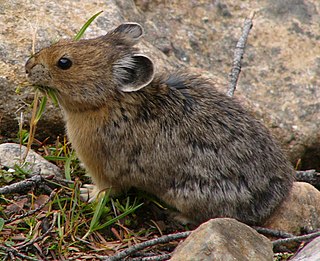
The American pika, a diurnal species of pika, is found in the mountains of western North America, usually in boulder fields at or above the tree line. They are herbivorous, smaller relatives of rabbits and hares. Pikas have two different ways of foraging; they either directly consume food or they cache food in piles for the winter (haying).

The great lanternshark is a shark of the family Etmopteridae found in the northeast and northwest Atlantic. Its name was given because, at the time of its discovery, it was thought to be bioluminescent, but this has been challenged.

Zapus is a genus of North American jumping mouse. It is the only genus whose members have the dental formula 1.0.1.31.0.0.3. Zapus are the only extant mammals aside from the Aye-aye with a total of 18 teeth.

The mountain ground squirrel is a rodent that is native to southwestern Angola, western Namibia, and western South Africa. It is also known as the Kaoko ground squirrel or the Damara ground squirrel.

The barred hawk is a species of bird of prey in the family Accipitridae. It has also been known as the black-chested hawk.

The scaly-breasted kingfisher or regent kingfisher is a species of bird in the family Alcedinidae endemic to central and southwestern Sulawesi in Indonesia. Its natural habitat is subtropical or tropical, moist, montane forests.
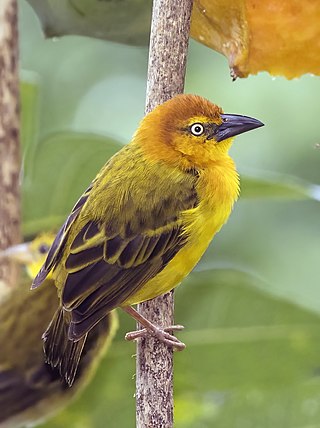
The Príncipe weaver is a species of bird in the family Ploceidae. It is endemic to São Tomé and Príncipe, where it is found on the island of Príncipe. It was described by Charles Lucien Bonaparte in 1851. Its natural habitat is subtropical or tropical moist lowland forests.

The western jumping mouse, is a species of rodent in the family Zapodidae. It is found in Canada and the United States.

Psilophyton is a genus of extinct vascular plants. Described in 1859, it was one of the first fossil plants to be found which was of Devonian age. Specimens have been found in northern Maine, USA; Gaspé Bay, Quebec and New Brunswick, Canada; the Czech Republic; and Yunnan, China. Plants lacked leaves or true roots; spore-forming organs or sporangia were borne on the ends of branched clusters. It is significantly more complex than some other plants of comparable age and is thought to be part of the group from within which the modern ferns and seed plants evolved.
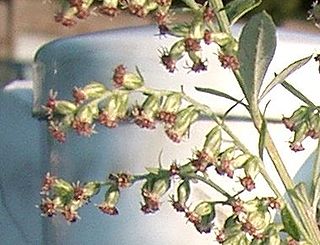
Artemisia princeps, also commonly called yomogi, Japanese mugwort, Korean wormwood, Korean mugwort or wormwood in English, is an Asian plant species in the sunflower family, native to China, Japan and Korea. It is a perennial, very vigorous plant that grows to 1.2 meters. This species spreads rapidly by means of underground stolons and can become invasive. It bears small, buff-colored flowers from July to November which are hermaphroditic, and pollinated by wind. The leaves are feather shaped, scalloped and light green, with white dense fuzz on the underside.
Roystonea princeps, commonly known as Morass cabbage palm or Morass royal palm, is a species of palm which is endemic to western Jamaica.
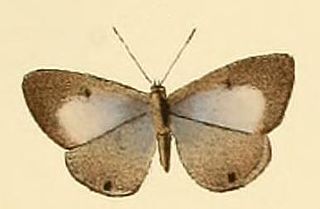
Anthene princeps, the cupreous hairtail, is a butterfly of the family Lycaenidae. It is found in Africa.

Epitheca princeps, the prince baskettail, is a species of emerald dragonfly in the family Corduliidae. It is found in North America.

Amanita princeps, the head man slender Caesar, is a species of agaric fungus in the genus Amanita. It is found in tropical China, Southeast Asia, and the Malay Peninsula down to Singapore. It is edible, and is collected in the wild and sold in local markets. Many incidents of mushroom poisoning have occurred among Laotian and Hmong immigrants to North America, since it is easily confused with Amanita phalloides, the death cap, in both appearance and odor.

















